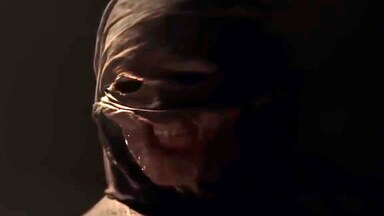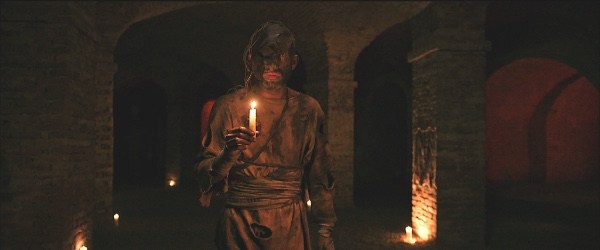 Most of us have heard the saying, “don’t judge a book by its cover.” It’s old and possibly trite, but it’s a true little collection of words. Although not nearly as novel as your sweet librarian reminding you of that principle, applying it to film is just as relevant. Not judging a film by its poster should be cemented in our cinephile brains just as firmly... ...Perhaps more than any other genre, horror films are often treated to a crude marketing circuit and many are grossly misrepresented. After my viewing of Emiliano Ranzani’s new film, Blood Bags, from High Octane pictures, I can confidently say the film is far removed from its cheaply produced, creature feature poster art. Not to knock on monster movies, as some of my favorite films fall under that genre, but Blood Bags is a much slower burn of a film. Despite the falsely advertised poster art and marketing materials, what really matters is what kind of film is revealed beyond the poster. The film places us in Turin, Italy as we follow two American girls, in the prime of their youth, studying abroad. Tracy, (Makenna Guyler,) is an aspiring photographer who is transfixed by Italian architecture and her friend Petra, (Marta Tananyan,) is just along for the ride. One day, while the two are out exploring, Tracy stumbles across an abandoned mansion. Tracy, being the persistent and passionate student she is, decides to investigate due to a potential photography goldmine. Petra excitedly follows her friend, seeing it as a fun opportunity to explore for fun. Before long, the girls come to the dreading realization that they are not alone and, even worse, the company with them may not be entirely human, or friendly for that matter. Blood Bags starts out rather strong. While not consistently so with the film’s boring lead characters, it did manage to hook me into its premise. While the girls are exploring the mansion, we see side events that help connect the dots of what’s going on and why the girls may be in danger. One scene in particular slowly reveals to us how the film’s antagonists gain their power and the kind of underworld haunts that make their existence possible. It’s well-constructed exposition and world building that’s exposed to us without much dialogue even. Blood Bags signatures itself as a more quiet horror film, contrary to its poster art. Just as I started to appreciate the slow, but captivating rhythm, the pacing is thrown off course. The film tries to stimulate the viewer with a sense of urgency, but it doesn’t feel earned. Up until a particularly eventful scene, the tone and pacing has been slow, steady and revealing at a good rate. It’s a jarring transition to panic and earlier plot points are not revisited. We’re also introduced to more characters, which are just as uninteresting as our leads. It isn’t even a problem of likability, but more of a lack of a reason to care. The impending doom and attempted tension falls flat because we’re just not invested in these characters. Probably the most glaring flaw in Blood Bags is the uneven script. It felt like two visions competing with each other, ultimately resulting in an uneven experience. When I discovered there were three writers for this film, it immediately made more sense to me. In the film industry, multiple writers for one project are often a sign of a fragile script. Blood Bags is no exception, as the first half approaches the story with a slower paced, quiet and almost timid perspective and the second half is a dizzying fumble of panic and death. They don’t transition well together, but out of respect to the writers, it does not prove that they are without talent. Both perspectives work well in their own right. They just don’t work together. It may seem like I’m being overly harsh on Blood Bags, but these are problems that don’t necessarily dampen all enjoyment. There are still plenty of admirable qualities about the film. As I previously stated, the film does open strong and it succeeds here by way of its technical proficiency, married with a clear tone. Cinematographer, Alessandro Mattiolo, provides a professional looking film and it elevates the quiet, minimal dialogue first act. There is a very interestingly shot first-person sequence that is accompanied by eerie disembodied voices. It’s slightly out of place, almost seeming like the film stops for its presence, but it is worth mentioning, even as a stand-alone scene. Composers, Fabio Di Santo and Daniele Prina should be commended for their work here. While nothing extremely innovative or even particularly memorable, it’s effective and compliments the film’s tone. It’s one of those scores that doesn’t jump out at you like a, sometimes obnoxious, John Williams theme. The score here doesn’t want to alert you to its presence, but rather act as an extension of atmosphere. I got John Carpenter vibes from it, if the synths were toned down just a bit. Blood Bags isn’t a bad film. Rather, it’s an uneven film. It’s merely a film that, if rearranged a little and given a more consistent script, could have made a lot of difference. Unquestionably, a lot of talent worked on this film and it does show. It’s just a shame that it’s sometimes overshadowed by the negative elements working against them. Despite what I think about the film, it’s important for us to not allow poster art to dictate how we judge a film or what we think the film will be like. Blood Bags isn’t a great film, but it’s a film I’m glad I was able to see. Had I allowed my shallow impressions of silly poster art to halt my viewing, it would be a bigger shame than a flawed, but interesting film. Blood Bags drops on VOD December 3rd from High Octane Pictures. By Jeffrey Hollingsworth
0 Comments
Leave a Reply. |
Archives
March 2023
|


 RSS Feed
RSS Feed